Denver Public Library Cultural Inclusivity Services
About this project
Most of us carry a piece of our home with us, whether it is a ring, a coin, a book, or simply a memory. Mementos from Home is an audio-visual exhibit created by the Services to Immigrants and Refugees team of the Denver Public Library. Staff and customers came together at the Rodolfo "Corky" Gonzales Branch Library to tell a story about the objects that mean the most to them.
New! Tell us about your memento from home!
What do you carry that is your piece of home? Upload a picture of your item and tell your own story.
|
Title: Ring Description:“[This ring] is very old. Unfortunately, I don’t know what kind of gemstone it is. This is my grandmother’s ring. I hope, God willing, I will have a granddaughter soon and I will pass one of the rings to her. Maybe both of them.” TranscriptSpeaking Russian My name is Evgeniya. At our event that is dedicated to the topic “Mementos from Home” today I want to show several items that are significantly, very important to me. I am going to separate them into 2 categories. I would call the first one heirlooms or heritage. And the second category represents traditional items that characterize and distinguish my homeland from other countries and continents. Speaking of the first category that I called heirlooms, these are the earrings that I still wear. Maybe they are not so fashionable now. It is a gift from my father (unfortunately, he died a long time ago in 1986). He bought those earrings for me despite the difficulties our family had (we were constantly short of money). But since he knew that there is a girl growing up in his family he decided to make that gift to me. So I have been wearing that gift for a long time. My father was a very serious man. He never punished us (sisters) because we are girls. He always supported us. Because of that I still speak to him in my thoughts asking for advice. And when life is really hard, I feel that my father protects me like an angel. This is not just something that reminds me of my dad, this is sort of amulet for me, my good luck charm. I also brought two rings today. The first ring has a ruby stone. The reason I remember it well is that the ring was given to me before my wedding day. Relatives on the part of my husband gave that ring with a ruby stone to me. Ruby is a stone that represents big love, big friendship. So, this first ring was given to me by my parents-in-law. My husband and I have been together for almost 40 years. But I don’t wear this ring anymore. I saved a receipt though that has its weight in grams, its price in the currency that doesn’t exist anymore (it all happened in a distant time of the USSR). The second ring is very old. Unfortunately, I don’t know what kind of gemstone it is. This is my grandmother’s ring. I hope, God willing, I will have a granddaughter soon and I will pass one of the rings to her. Maybe both of them. The second category of things that I brought today includes traditional household items that people used back in the day in the place where I was born, in Uzbekistan. As for Uzbekistan, it is one of the most ancient civilizations. Just recently, people celebrated nearly three thousand years from the date of its foundation. That is why many tourists buy household items as mementos from their visit to Central Asia. The first two kits from this category are… As you know, it is very hot in Central Asia, as hot as in the desert for some parts of Central Asia. Surprisingly, people drink hot green tea in hot summer weather to create some kind of contrast between temperatures. When people drink hot tea they feel extremely hot at first and then they feel cold. Here I also have kettle stands and hand fans for women, so they can cool themselves while having a conversation at the cup of tea. All of these items are made of fabric. I bought them in Tashkent. There is an old place called Bazaar that sells things which look like antiques. I went to a special place called Chorsu Bazaar. “Chorsu” is its name, and “Bazaar” means “market”. These things have a very peculiar pattern that Uzbek people use to design different things (carpets, tablecloths). And the third thing from this category looks similar to bead necklaces but it is not a necklace. In this case, it is an amulet that protects from curses. A lot of people call this amulet “chotky” (prayer beads) if they are made of gemstones. It is quite popular among older adults. In my case, I hang them in my car as an amulet. There is a place by the mosque in Tashkent where an old man can give you prayer beads when you make a donation of a certain amount. And that is where I got those prayer beads. The name of the mosque is Kukeldash. I believe that the mosque is older than 2 thousand years. I might be wrong about that, I am not sure. But it is a very old mosque. Firstly, these items are important for me and for my family. Secondly, things that I bought in my home country help me not to forget the place where I was born, grew up, got an education for the first time. That is why I believe that everything I brought with me today is important to me, and that is why every person should have things like that. I have antique books but I believe that it is impossible to take them out of my home country. I think so because it was very important for my husband to take a chromatic button accordion with him, but right at the airport we were stopped and were told that we can not take it with us across the border because border control believed the item is antique. Later, I sent the accordion by the postal service after getting a document at the special office that proved that the accordion is not antique and it does not represent any value to the government of Uzbekistan. Now the accordion is here with my husband. Thank you very much for listening to me, for making me remember things that are valuable to me for one more time. This interview is also valuable to me.
|
|
Title: Gobi Description:“I have more than two dozen gobis. I just chose a few to show here. Someone who loves gobis can’t just have six or seven. No, he has to have a lot. I bought them in Porto-Novo, Benin. And you might have noticed that I brought different types of gobi of different qualities. There’s the kind that’s woven with fabric, with different colors. There are some gobis that are passed down from our ancestors. When you feel the quality of the fabric, you already know what it is. When you wear them, you really feel at ease. You’re very relaxed at events, and you’re set apart…. When you put on your bohoubna, and you put your gobi on, even if you don’t have a single cent in your pocket, you put yourself in a certain class and you feel at ease among the other guests.” TranscriptSpeaking French I come from Benin. I was born in Porto-Novo. I really wanted to talk a little about cultural things from my home. I chose the hat we call gobi [traditional short hat]. And that's what I'm going to talk about today. To discover its secrets, we have to go to Porto-Novo, the capital of Benin, about 20 miles from Cotonou, the economic capital. If you live in Benin or you travel there, you've certainly come across this hat worn by Beninese people at different special events, usually festive events, for example: weddings, baptisms, anniversaries, and traditional ceremonies. What is the gobi? It's a magnificent hat, widespread in this region - Porto-Novo. It's very supple and cylindrical in shape. Most are made from woven fabric. It usually helps distinguish certain men from one another at special events. There is a very precise meaning - these are men of Goun and Yoruba tradition who usually wear it. I mention Yoruba because we're at the side of the big neighbor to the east, Nigeria. Yoruba people are originally from Nigeria. These two traditional ethnicities wear this. When it's flipped to the right side, it shows that a man is of a certain social class. A respectable class of men. When it's flipped to the left side, the wearer is of a lesser class. When I talk about class, I mean rank - social status. Even if people today, above all young people, don't really understand the true meaning of these things these days. The purpose of the gobi above all is cultural. It's very cultural. And we often put it with a local outfit, called the bohounba in our language. When you see a man in his Sunday best, really looking good, well-dressed, with his gobi on, it also makes women pay attention. It makes him shine. It makes feelings come easily - it’s attractive. It makes you attractive. It attracts a relationship, because it puts the man in a certain class, and people want to come and talk to you. Simply because your clothes look really good on you. These days we see young people who devalue/degrade these things by wearing this hat with a French outfit. But in fact, the gobi usually should go with a bohounba. I should also tell you that often, when you see people put on the gobi in Benin, the color also matters. When you look at the colors in the gobi, you usually have to be able to find certain colors of your outfit in the hat. If not, they don't go together. Also, you won't see anyone wear a white bohounba with a white gobi. The colors that go with a white bohounba are: black, yellow, red, blue. Also, when you wear a multicolor bohounba, often you wear a black gobi. Or you might see a color in the bohounba that's not spread throughout the fabric - you look for a color that's not highlighted in the fabric, and it's that color of gobi that you'll put on your head. To bring out the more subtle color in the bohounba. We learn this - people learn this in school, and we also go to our elders to learn about this. We see our elders dress up, and we learn the history of the colors - this color and this color go together. This color plus this color don't work. That's how we learned it. They give us an orientation: “when you wear a white bohounba, you have to wear a black, red or yellow gobi. And when you put on a multicolor bohounba, you look for a subtle color in the fabric, and look for that color gobi to wear.” That's how we choose the gobi. And the gobi, I’ll tell you - when you want to go to church, for example. When you arrive in front of the church, you have to take off your hat. You have to take off your gobi. No matter what class you come from. You can’t leave the gobi on your head to go into a church. And you might see that there are great people there - when you enter to greet them, as a sign of respect, you take off your gobi, and you greet them respectfully. And the whole time you spend in front of that great person, the gobi shouldn’t go back on your head. As a sign of respect for your elders, and for older people who are there. So it’s not a hat that we wear in disarray, wherever we are, wherever we go, no. We wear it for events. I have more than two dozen gobis. I just chose a few to show here. Someone who loves gobis can’t just have six or seven. No, he has to have a lot. I bought them in Porto-Novo, Benin. And you might have noticed that I brought different types of gobi of different qualities. There’s the kind that’s woven with fabric, with different colors. There are some gobis passed down from our ancestors. When you feel the quality of the fabric, you already know what it is. And I continue to order more in Benin. Because while I’m here, people are still making them at home. So I shouldn’t just make do with what brought with me and tell myself that I already have gobis - no, no. Each time I find someone who’s going back to Benin, I say, “Listen - try to find me some gobis that are really in style, and buy them for me.” When you wear them, you really feel at ease. You’re very at ease at events, and you’re set apart. You’re someone - you see, we say, “the clothing doesn’t make the monk.” But it does shape the monk. When you put on your bohoubna, and you put your gobi on, even if you don’t have a single cent in your pocket, you put yourself in a certain class and you feel at ease among the other guests. I’ve kept them because they’re very important for me. They’re cultural for me. Here we’re thousands of miles away from Benin - if I’ve brought it all the way here, you have to understand that it’s something very important to me. I know there aren’t people who wear it here, but just because I’ve come to the United States, I’m not just going to leave behind my culture or leave behind my traditions. When I’m in my prime here, I have to remember to put on my bohounba and gobi to make myself stand out in American society. To show the difference - so that people feel that this man comes from Africa. He comes from Benin. He was born in Porto-Novo. Just because I’m in the United States, that doesn’t mean my culture has to disappear. So I’m not often keen to wear - like you do here (I’m not saying that it’s bad) - jeans, sweaters, jackets, suits, no. I have to wear what I also wear in Benin. It’s an emblematic hat for us. That’s why, you see, even when I get on a plane and they tell me there’s not enough space for all these hats, I say “No! That’s out of the question.” I prefer to leave behind something else and find space for these hats, to show off my country - the Republic of Benin. To highlight my region - Porto-Novo. We have other cultural things at home - there’s something we call égougouns - revenants. That’s something we love in our country. Revenants. You see, in Africa we say that someone who dies is not dead. It’s a practice for us during certain times of the year to remember our dead, and we organize a party - a festival - and we play and we feel at ease that the dead are not dead. I would love to at least bring photos, the égougouns, to the US, but when I remember that they’ll weigh a lot in my suitcase, I have to leave them. There are many objects that I really would like to bring to the US from my country. But you know, when you take a plane you only get two 50 pound bags. Otherwise, there are a lot of things I could bring here. Since gobis are not heavy, I preferred to bring them.
|
|
Title: T-Shirt Description: “I brought this George Michael baseball tee from his 25th live concert in Miami in 2008. When I touch the shirt, it reminds me of that moment. The whole experience. And I will never forget. I keep it in a very special place. In all my moves, it goes with me, because it is an important part of a great time in my life.” TranscriptSpeaking English I’m Giselle. I have been here for three years ago. I love being here. Even with the extreme weather - as they call Colorado’s weather - the people here are so nice: friendly, open-minded. So I feel lucky being here. I brought this George Michael baseball tee from his 25th live concert in Miami in 2008. It has the picture of George Michael with a guitar, and you can wear it with jeans, with shirt, with leggings… well, actually, I wear it everything, you know? Also with a dress. And as a pajama. In the last moment I wore this as a pajama. I remember that time of the 80’s as one of my best moments. The parties, the fashion, movies, and of course, music. One of my favorite bands was Wham! They were a super happy band, colorful videos, the fashion trend, I love it all. Because it was so colorful, you know, the videos. It was so funny, so happy, so the people it was like at the concerts or maybe you know it just...it was one of my first… when I recorded the VHS (I remember the VHS) I recorded my VHS video, so I kept it with me all the time. That’s what I love. Well, and of course, the music. I became a fan. A really fan of this band and I followed them in its entire process until George Michael became a soloist. I was a fan of him since he started. You know - he was British, no? A London band, a British band. And I loved all the, you know - his movements. Yeah, I loved his style, you know? All the time. So when I saw the concert announced in Miami on his web page, of course I had to be there. Yeah, because I lived in Mexico so I had to travel there. I told my friends, but no one was as fan as me. So my husband, as an emotional support, traveled with me. And yes, of course we bought tickets to the front row. I had to see him face to face. Then, the concert started and I couldn’t believe it. I sing, dance, sing again and again. I didn’t sit at any time at all. It was George Michael and I. At that moment, the concert, it was like “Oh my God, amazing!” It was the new trend that is like lights all around the stage. It looks like it was like, the huge… when he started singing, “Freedom” or something, it was like the whole world around him - so it looks like you were part of the stage. And also it sounds like, because it seems like he’s going to come from a helicopter, so it sounds like “chk chk chk chk” something like that, and he’s just, like, going down to the stage, so it was amazing. All the people was like screaming out loud. Oh my God it was my favorite concert. Because I love him, but also, you know the people it was so - how do you say - overwhelmed. Also, you know, it was diversity, so all from all kinds of people you can imagine. It was so friendly, you know, it was a really really really nice concert. That’s why I love this guy, you know because it’s like, it was for all the people, not just one - how do you say - one public. It’s from families, boys, girls, whatever, kids, couples. Nobody wanted to leave. We kept applauding for him to return to the stage, but it was so late and we should let him go. When the concert ended, we went to dinner and my husband gave me the shirt. It couldn’t be at a better time. From that moment, I didn’t stop wearing it until it didn’t fit anymore. Actually, it’s so trending nowadays, no? Even if I bought this - well, my husband bought this - many years ago, right now I think it could be perfect for anyone. It’s a trend right now, actually. So yeah, it’s vintage. When I touch the shirt, it reminds me of that moment. The whole experience. And I will never forget. I keep it in a very special place. In all my moves, it goes with me, because it is an important part of a great time in my life.
|
|
Description: "A prayer rosary; this is very precious and valuable to me, because I got it in Mecca when I was performing my Hajj pilgrimage in 2010. It was an experience of a lifetime, to be at the Holy Place, with millions of people from every country who were having their own spiritual journey. I have used my misbaha in my daily prayers ever since. To give glory to my God and to recognize his mercy and power gives me peace of mind." TranscriptSpeaking French and Moroccan Arabic The object I have is something I brought home from Saudi Arabia when I made my pilgrimage in 2010. I brought this object home to Morocco, then I brought it here. It always keeps me company, even while I’m sleeping. It’s a rosary that I ?filled with/used for? all my prayers to thank God for allowing me to take the pilgrimage, and for giving me good health and well-being… that’s all. It’s important. It’s always with me, even when I walk - during my daily walk. It’s been almost seven years. Yeah, from 2010 until 2018, that’s almost seven years. And even when I travel and go to Morocco, it’s always in my pocket. There are objects that give you confidence, that give you serenity, that give you peace with yourself. Even when you walk alone. I was in Mecca. I was sitting down praying the maghreb prayer, when a woman passed in front of me, and she gave it to me. It was a gift. Like sadaqah - like a donation. People there want to do good. They want to give, they want to do charitable things. So a woman that I didn’t know walked in front of me and gave it to me. And I kept it. I bought some for my friends and family in Morocco - I bought more of them. But this one, I kept because it was offered to me. It was a gift from God. I am happy to share this moment with you. It’s a pleasure to share. Because in Morocco, people aren’t closed off. You find people in the street, in the mosque, in the hamaam - do you know the hamaam (bathhouses)? And we talk, we talk! We discuss things! We’re used to to people - to the presence of people. Me, I’m open. The difference [here] is that when I’m going from my house to the mosque, or from my house to the library, there aren’t many people who walk. Whereas in Morocco - well, these days many people have cars - but even so, we walk. We go out, we take walks, we have picnics. Conviviality doesn’t exist here. People here come together at parties, special occasions. But there, every Friday you see a family prepare couscous, and we come together around the table. Neighbors, friends, family. It gives you warmth. Speaking Arabic This couscous we cook - you know couscous, right? We cook it and make a big plate, and we call it Gsaa (the plate), this is where we knead it. And we come together. All the family comes together. Speaking French Now that I’m in Denver, I don’t make couscous on Fridays anymore. Couscous is a dish that requires people - a large presence of people. You can’t eat it alone. I made it yesterday, and it just sat there. No one touched it. You see? That’s the difference.
There [in Morocco] on Fridays we make a big platter of couscous and we bring it to the mosque. To share with people - the poor people who come. And these people have the opportunity to eat well, to eat meat and chicken. You see? That does good. Sadaqah - we call that Sadaqah. Charity - that’s it. Charity. And we pray to God that he accepts it and forgives us, that’s all. That's why I always have my rosary with me. My prayer rosary. My prayer rosary.
|
|
Description: "This dress is from my sister's wedding. I got this dress from Iran, and it is a wonderful childhood memory, and it has special value. It brings memories of my childhood, and it reminds me of my birth place. Whenever I see the dress, I remember happy times." TranscriptSpeaking English My name is Zahra Ibrahim. I’m from Iraq, but my nationality is Turkish. I’ve been here for twenty years, and I work at the library as an Activities Leader, and I do my job with love, with passion. And I like to do it and I think I will be able to do it for the rest of my life because I love it so much, and I work with really great people. I brought a dress with pink hemmings, I should say? I don’t know, like lace, it’s kind of a white-ish but not quite. It brings a lot of good memories. It’s a childhood dress that is very sentimental to me. I got it for my sister’s wedding in Iran, in Tehran, in 1994, when I was only seven years old. It brings a lot of, as I said earlier, it brings a lot of great memories, childhood, I had an amazing childhood, so I always go back, it takes me back, because when I touch the dress, when I smell it, it reminds me of home. Ah it fit perfectly! Because at the time, I don’t know, as I said it’s a great memory, family, home, the smell, the touch, the feeling. I wish I could go back, but unfortunately none of us could go back. I want to pass it on to my great grandchildren if I had a chance. If, if I get married! But yeah, definitely.
|
|
Description: "I received this baby chair when I was 6 months old as a gift from my godparents. It was bought in their native town of Morelia Michoacan, and brought to me in Tecate, Baja, California back in 1978. It is the only physical object, besides photographs, that I was able to bring when we migrated to the U.S. It is a connection with my culture, godparents, and many memories of different babies in the family using the chair (that's why it's a bit beat up). It reminds me of my godparents and my childhood memories, where this chair is shared by many in the family. Also, it is one of the few (if not the only) physical object that I owned in Mexico and still have today." TranscriptSpeaking Spanish Good morning my name is Jorge Romero, and well I am participating in this project and today the Memento from Home that I’ve brought comes from Mexico. I brought it when we moved or when we immigrated to the United States in 1993, and it was an object that I acquired in 1978 from my godparents at my baptism. It is a chair, made in Morelia, Mexico, where my godparents were originally from, and it is made of wood and the seat part of the chair is made of fibers - I don’t remember exactly what they’re called - but they are plant fibers, and the fibers are braided to make the seat. At one point the chair was blue, and now it is a bit, now it doesn’t have much color, it is a little bit broken. It is at least 40 years old - I don’t know when it was made, but I received it 40 years ago. Well it is important to me because it is something, it is a physical object that I have from when I was little, when I was a baby. When we came to the United States we left everything behind, and for me it is very significant because my godparents gave it to me when I was baptized, after my baptism. So for me it reminds me of my childhood because many of my cousins, my relatives, used it when they were babies, and it is also a connection to my godparents and now to the memory of them. It is very nostalgic for me. I brought this, it is one of the few things that I have that connects me to Mexico, to my ancestors, to my relatives, to my godparents, and it is very important to me even though it is now very old, though it is a little broken, it means a lot to me. Well, one of the things is that I thank you for doing this project, and that’s because I believe that for many of us it’s important to share the few things we have been able to bring from our countries, that remind us of our countries, that in some way connect us to what we are, so that we never forget, even though we live over here. And I think it is a very special project and gives us the opportunity to share a little piece of what our country was, of how we lived, of how we felt. So thank you.
|
|
Description: "I got these cards from China. I love cards, and I enjoy the game of chance. Everyone has access to a deck of cards; all barriers are removed. Kids' games to high stakes, like we see on T.V., are some representations of how universal a deck of cards can be. The same deck of cards can be used in different games across the world. It's so GREAT." TranscriptSpeaking English I’m Ed, Ed Kiang. I brought a deck of cards I recently acquired from China. It’s so cool I think. Yeah it’s called the Chinese Generals and Marshals. It’s something that, you know, is like old day, Cold War memorabilia that you can only get from China - and at a considerable discount may I add! It’s the latest acquisition of something from China, that’s where I’m from. And I like to keep things that’s meaningful to me. Like, I like to tell people that if it was something meaningful, for example the first project from my daughter’s kindergarten class, I keep. Like when I asked my wife to marry me I sent her a huge fortune cookie and I still keep that fortune cookie. And things like that. So it’s meaningful. It will eventually go from display, until I get something new, and then to the boxes I keep at home. I will always read them, especially you know, the good thing about this is because it’s a piece of history also, it tells you a little bit. So a lot of times like when I watch movies and TV shows and read books, and it mentions somebody’s name, you can use that as a cross-reference to see if in the deck of cards, if what it says is true. That way you can tell if the book is inaccurate, or if the cards are misprinted. You know, after all, I am a librarian! It’s history. It’s also part of me because I’m from China. I like to keep things that I get from there. I like to get little mementos, souvenirs, of the places I visited. You know it’s like keep fresh of memory, you know making connections, you know because you tend to forget a lot of things. I think with some physical item in your hand you can bring back a lot of fun memories.
|
|
Description: "As a child, I would ask my mom for a peso to buy some animal crackers. It didn't happen often. One time, my dad had just arrived from "El Norte," and we asked him for 50 pesos. He gave us 100 pesos, and we spent it all on animal crackers. Three kids with 300 pesos-worth of animal crackers lasted a long time." TranscriptSpeaking Spanish I am originally from Zacatecas, Mexico. I came to this country 28 years ago. The objects I brought for the exhibit are two coins, a one-peso coin and a hundred-peso coin, that show the years 1990 or 1988 on top. These two coins are significant for me because they speak to when we were children and my father lived here in the United States and we lived in Mexico. The times when he would visit us, he brought us little things, different things, to show us that he was back and that we had been in his thoughts. And when we were young, some time ago, my mother asked my father for one peso for us. It was my older sister, my younger brother and myself, so she asked for one peso for each of us to go buy animal cookies from a man who had a store called Don Cesario. We went to that store and asked for animal cookies, one peso worth. And he gave them to us in a paper cone that he made, and the three of us left with our animal cookies, very content. On one occasion that my father came to Mexico we were going to ask him for one peso so we could buy animal cookies. And I remember that I said to my brother and sister, “we’re going to ask him for 50 pesos! Because if he’s coming from the United states, if he’s coming from the North, he must have a lot of money!” But my older sister said, “no Vivi, no, only one peso, only one peso!” And so we went to my father and asked him, “Papa can you give us one peso to go to the store?” And my father said, “what are you going to buy?” And we told him we were going to buy animal cookies. So he said yes that he would give us money - and instead of 50 pesos that we were asking for, he gave us 100 pesos. And with these 100 pesos my brother my sister and I went to the store; kids of about 6, 7 and 8 years old, we went to the store and bought 300 pesos worth of animal cookies. We returned with giant paper cones filled with many animal cookies. And when my father saw us he asked us why we bought so many cookies, he said we could have bought a different kind of cookie. But we said, “no, because the animal cookies will last us.” This was one of the few times I saw my father cry. When he saw that we tried to do as much as possible with what we had, and that he had given us 100 pesos - and 100 pesos was a lot - we could have chosen the sweetest cookie, the most beautiful cookie, but we chose animal cookies because we wanted them to last as long as possible for the time that we had with him - usually he stayed two weeks in Mexico with us. After that was when my mother asked my father if he would live with us in Mexico or if we would go to the United States to live with him. And for this reason my mother has her contribution in this exhibit as well - her bills and her shoes. This country has given us more than we would have been able to have in Mexico. But at the same time, while we’ve been able to have so much here, we’ve had to pay a high price. We’ve lost members of our family who are now no longer with us. It has given us successes, it has given us joys, it has given us triumphs. But the memory of coming to the United States where three of us were going to die and only one of us was going to be able to stay. Now he has been deported, my older sister passed away, and now the only ones here are my mother and myself. My father is far away, and my sister is far away. But being here has given us a strong life experience, and we have valued every day and our existence, thanks to God.
|
|
Description: "These cards are important because they remind me of my family and my friends back home in Argentina. The cards remind me of those evenings and weekends when we would get together and play Truco, a very social game where you trick your opponent by playing quickly and distracting them with conversation. Playing the game was a way of connecting with friends and family. They remind me of fun times, and I enjoy teaching other people how to play even though it can be a difficult game to learn." TranscriptSpeaking Spanish Today I brought a Spanish card game that is different than your typical card deck, like ace of diamonds, this one has walking canes, swords, goblets, and coins. This is something that I brought with me when I came here 15 years ago from Argentina. It was a playing card game that I used to play with my friends. We would get together on the weekends, in the evenings, to play this card game, and it was a very social game. I would like to find people who play the game that we used to play - it’s called Truco - but yes it’s a beautiful memory of being with my friends and everything, and of Argentina more than anything because it was a big part of my life in Argentina, and for this reason I brought this card game with me. I know the rules are a bit complicated for someone who doesn’t speak Spanish, but it is truly a very fun game and I would like to be able to find people who play! So if you play Truco, let me know!
|
|
Description: "In 1990, when we lived in Mexico, my husband was in the States. I gave him an ultimatum to bring us to him. I sold the two horses we had. I saved the money and brought it with me in my shoes. Throughout the trip/journey back and forth to the border, I kept my money in my shoes for fear that our savings would be taken away." TranscriptSpeaking Spanish I am from Aguas Calientes. I came from Mexico in 1990. When I came I brought my four children. In regards to the money, [my husband] sent me money to Mexico and I had to cash it because I had to pay for the work arrangements for the land. I brought money from Mexico, as I came, I brought large bills in my shoes. And I sold two horses because they made me angry. It seemed simple. I thought, “if the man comes tomorrow to buy them…” And luckily he did, and so I sold them, and brought the money with me for travel expenses. I told my children’s father that he would either come to live with us in Mexico, to suffer, or that he would bring us all there [to the U.S.] because I couldn’t keep my kid at home, he wouldn’t stay home, he would get home whenever he wanted, I couldn’t go out and look for him because a woman on the streets alone looks bad. I brought the money in my shoes, and I was hurting because I got blisters, but the money got here safe, I had it in a bag. [My husband] told me to sell the horses. And I told him that I already had sold them. He asked my why I hadn’t told him, and I said because they made me angry. I told him, “You are coming back here or you’re bringing us there with you. We will all suffer together there, or all here.” And I told him, “I don’t want to be here on my own, I’m struggling, it’s challenging.” I was sick frequently with bronchitis. I couldn’t be alone handling all of this. I had to come here. And here I was sick a lot as well, until I got used to the climate here. We got caught twice by immigration, we took about 15 days to cross the border, we went from house to house. I faced danger with my kids. In a house there was a guy that wanted to stab every child there, so I would stand in the way of him doing it. Then the Coyote got there, I was already on my way out the door, we were in Juarez all five of us not knowing but we traveled all over Juarez, and then he found us a cab and he brought us to Juarez looking for my friend’s address, after that he left us with her, but after that I didn’t know where the car was going or anything but I had faith with me and a little saint [inaudible] that a guy donated. I didn’t let anyone check me because I had money in my shoes. They would ask me if I had money and I would say no, so they didn’t search me. They has us locked up, I got into an argument with an immigration guy, I told him “just because I am Mexican and my kids are Mexican, I am not going to let you humiliate me and do whatever you want." I would defend our suffering, my kids, me alone, the expenses we had, I would get sick, I would struggle and that's why he brought us here. I got here and gave everything to their dad and he saved it, but yeah the journey was a lot of suffering. The first time she [my daughter] fell into the river her hair got stuck, she had long (hair) below the curve, I got her however I could, I had never been under water with my eyes open, I pulled her out by her hair and I brought her up. The oldest almost drowned, so I did the same thing to get her out, The Coyote told me to leave her there that she was already dead. I told him “she’s not dead, do whatever you want but I’m going to get her out.” In that same moment [my daughter] went into quicksand and she had her hair a little above shoulder height, and however I could I also grabbed her by her hair. It hurt her and it hurt me, but I got her out of the quicksand. My son also suffered, but God wanted him to be safe, because we would cross the street between the cars and he would yell at us, whistle, to hurry. But the cars were going at high speed and I couldn’t get to him and it kept raining, but here we are.
|
|
Description: "The ruby ring is my husband's, and he has worn it for the last 17 years. The smaller stone is mine, and it has a prayer engraved on it. The green 'elaegg' is my protection and sanity. When I went to Iraq in 2014, I was going through some of the hardest years of my life. I visited the Holy Shrines in Iraq and prayed. I cried and prayed. I got the 'elaegg' from one of the shrines, and that same night I had a dream about the Imam of that shrine. In my dream, he told me that he sent me the 'elaegg' as an answer to my prayers and as protection for me. Within a year, I met my husband, and our two worlds collided. It turns out that he got the ruby ring from the same shrine where I got my stone and the 'elaegg.'" TranscriptSpeaking English My name is Naghem Swade. I’m the program coordinator for Services to Immigrants and Refugees at the Denver Public Library. I brought a couple items with me to be photographed today, and they all have significant meaning. So the items that I had, and you can see in the photograph, the green elaegg isn’t as visible, it’s just kind of resting on my hand. And it’s a rectangle piece of cloth and it has gold engraving on it. And elaegg in Arabic means it’s just a special piece of cloth and it’s visited a holy shrine in Iraq. And it has the names of the Imams, the Imams, the Ahl al-Bayt, they are the family of the Prophet. Saints if you will. Sometimes I’ll take it out, I’ll put special perfume on it so the smell will still stay the same. Whenever I’m sick, physically sick, whenever I’m stressed out, whenever I just miss home, it reconnects me back to the land that gave birth to me. And then I have a really small stone and they call it heriz in Arabic. And the actual stone it’s marble with light brown and tan-ish colors. I can’t see it, but with a magnifying glass you can actually see the engraving of a prayer and it’s meant to protect whoever is holding it. And then my husband has a ruby ring. And if you look closely enough there is a prayer engraved inside of it and it looks like there’s a face. And he’s been wearing it for the last seventeen years. It was really interesting because I was talking to my husband about this project and I was asking him if he had anything. And as he was telling me about his ring, I was like, you got your ring from the same exact place that I got my objects from. So I came to the United States in 1996 when I was seven. And I had visited Iraq in 2014 and I had gone at a time that was very difficult for me; I was going through a lot of life changes. And one of the reasons I had gone there was to visit the holy shrine and it was in Karbala. It was super packed because it was a holiday season and I had just wanted to visit the shrine. And I was, you know, just very in love with the Imam of the shrine, the protector of the shrine. And I kept praying and saying, you know, “if everything is okay with me, if you accept me as who I am,” I was talking to the protector of the shrine, “I just want to be able to touch the window.” And somehow, like the crowds just parted and I was able to reach the window, and as I was walking, I had my hands up in prayer and this green cloth fell into my arms. And the ladies behind me, they’re like, “oh my god you got your wish granted, you got your wish granted!” And the pessimist in me was like, “no, no someone just probably threw it and it landed in my, in my hands.” That same night I had a dream about the Imam of the shrine. He came to me in my dream and he was like, “Don’t ever doubt me again. You asked for something, and I gave it to you. And that is a symbol that your wish has been granted. Wherever you go, keep this elaegg, keep this cloth with you for your protection and for your sanity.” And then I also from that shrine, I was able to get a stone and it had a prayer engraved in it. And then a year later I met my husband. And we got talking and our two worlds collided because he had gotten that ring seventeen years ago from the same exact shrine that I had gotten my elaegg from and my stone from. And I keep it with me wherever I go now because whenever I am panicked, or I’m having an anxiety attack or I’m just so stressed out from work or family or whatever it is, I remember that moment when that flag, when that elaegg, fell into my hand, and just this wave of calmness just falls onto me. And I remember my dream and I remember what he said, and so I keep it with me wherever I go. Coming to the United States as a refugee, and coming to the United States as a child was really hard because I had to leave my entire world behind and learn a completely new language. And it’s very expensive to go back home now, to go back to Iraq. And I miss Iraq. I have two homes. I’m a hybrid of two cultures. And sometimes I just want to go back to my roots, to the land that gave birth to me. I miss the smell. I miss the soil. And unless I’m willing to pay like $5,000 every year to travel back and forth, I can’t do that. So whenever I’m feeling homesick I take out this elaegg, I’ll borrow my husband’s ring, and I’ll take this stone that has the prayer engraved on it, and I’ll just, you know, I’ll rub the cloth on my face and I’ll just inhale because still to this day, four years later, it still has a very special smell to it. And it reminds me of home, you know? It reminds me of the place that gave birth to me. It wasn’t safe. I had to, you know, my mother and I had to flee Iraq because of persecution. It wasn’t safe. But at the end of the day it’s still the land that gave birth to me. I have two homes. I have the country that opened its arms to me and protected me, and then I have the country that gave birth to me. Speaking Arabic The elaegg of Abu Fadl (the Imam) protects me. Sometimes when I feel tired or missing Iraq, I just smell the elaegg and I go back. I am able to travel back in time to Iraq some 20, 22 years ago. I remember my grandmother, my grandfather, my aunts. It’s true that I am live in America. America is my country as well but Iraq continues to be my roots. The soil of Iraq, the ground of Iraq stays in my memory. Whenever I miss Iraq, particularly whenever I miss the religious pilgrimage to the Holy Shrines in Iraq, the pilgrimage to Abu adul-Alaah al Hussein, I take out my heriz , my husband’s ring and my elaegg, and I find comfort. My soul is at peace. Every single sorrow and trouble that I was carrying on shoulders just disappears. Just seeing these mementos and smelling them, I am at peace. |
Mementos from Home is sponsored by Denver Arts & Venues.
Background music
"Looking Back” by Lee Rosevere
From the Free Music Archive, CC BY-NC
Usage Attribution-NoDerivatives 4.0 International
This project has been made possible by contributions from the following Denver photographers:
Daniyom Bekele
“For the past few years, photography has served as a hobby that has helped keep me focused on admiring what's around me. From close family members to the picturesque outdoors of Colorado, through photography, I have been able to capture moments that express the vision my mind brought forth.”
Rosa Enriquez
“I have been fortunate enough in my life to have to ability to express myself and my creativity through art. Photography is one of my many forms of art that I use to express my creativity. A few years ago, I invested in a DSLR camera and was determined to learn the art of photography. Taking classes at the University of Colorado Denver and practicing on friends and family, I have learned to use my camera in a way that captures beautiful images of my subjects. Portrait photography has been my favorite type of photography, not only because I get to capture beautiful images of people but also because I get to know them on a personal level.”
Rosaenriquezphoto
Transcription, translation and interpretation provided by: Dmitry Konoplev, Nicanor Diaz, Amma Romero, Viviana Casillas, Amanda Savasky, Naghem Swade, Virginia Vassar.
Audio recording and editing by Virginia Vassar.
If you have a memento from home that you would like to share, please contact the New Americans Project:
720-865-2362
plaza@denverlibrary.org
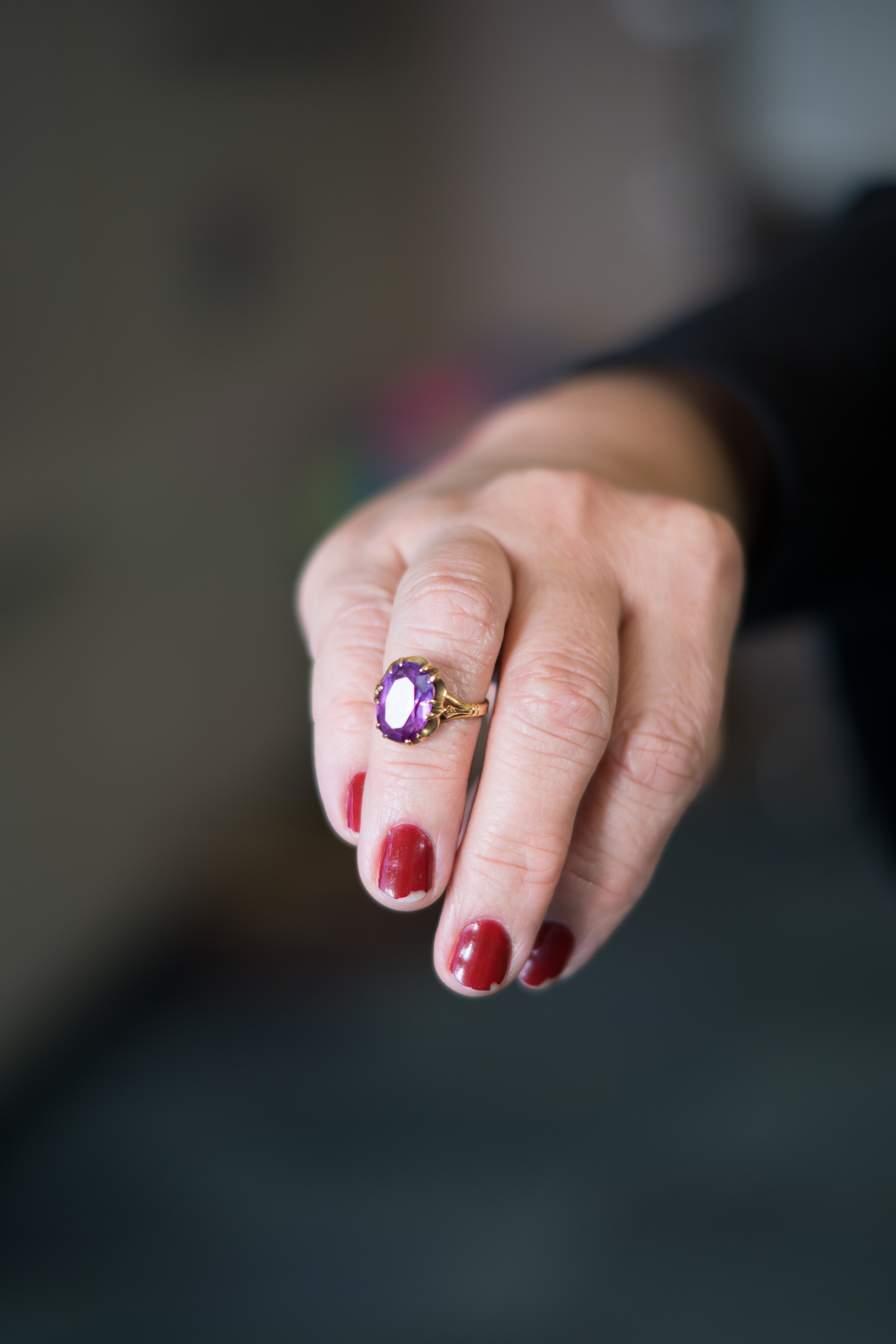
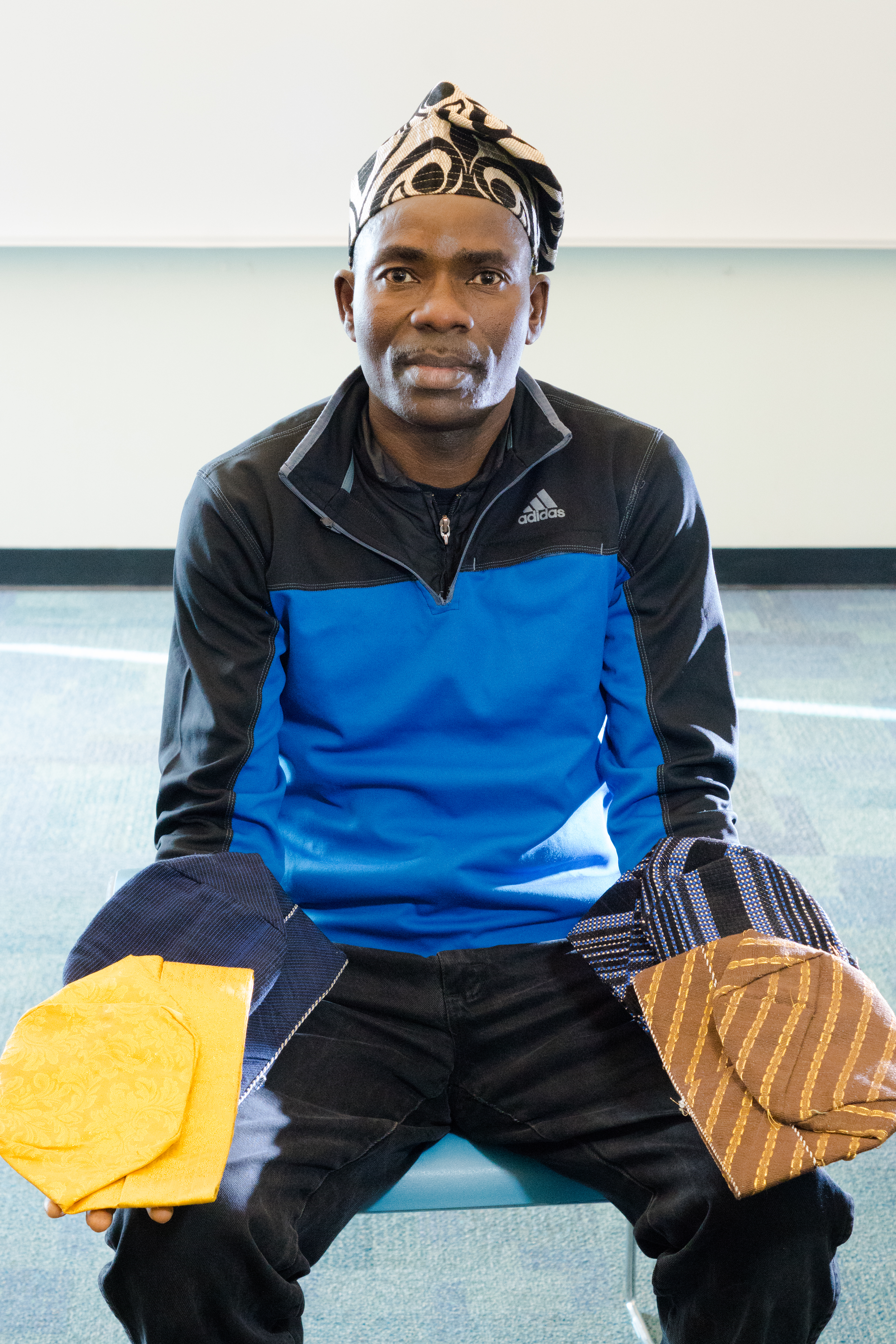
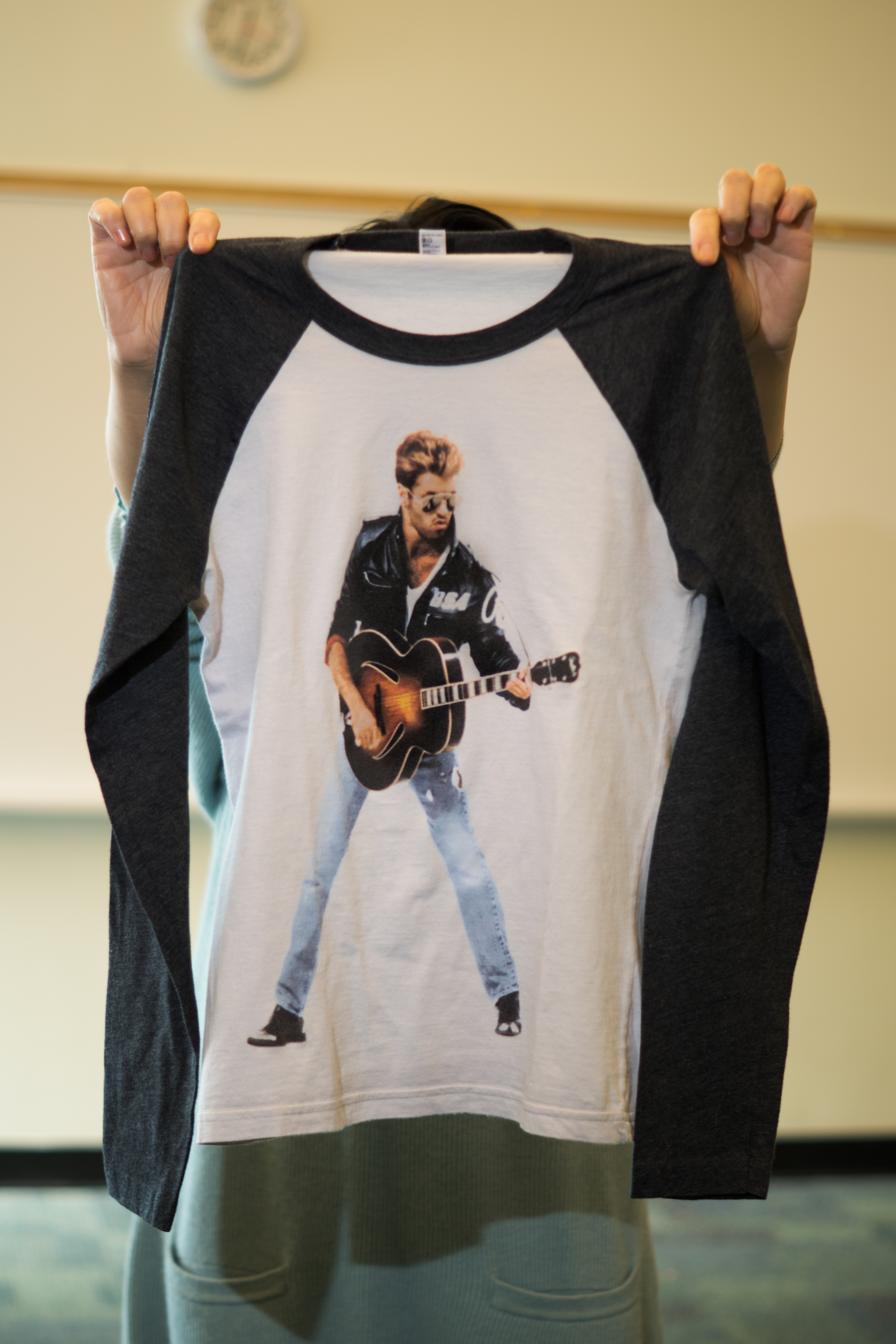
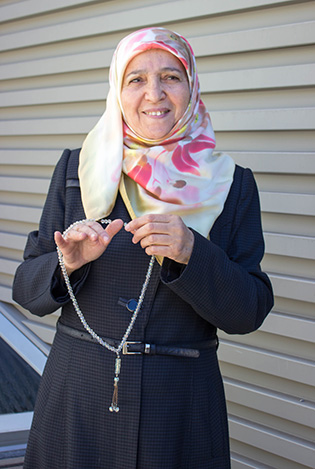 Title: Misbaha
Title: Misbaha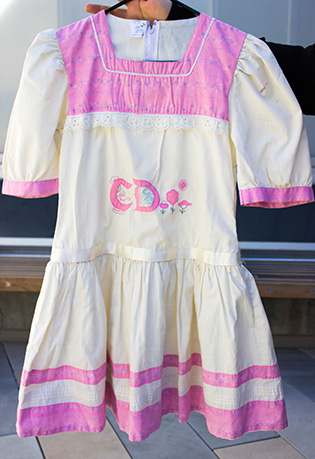 Title: Party Dress
Title: Party Dress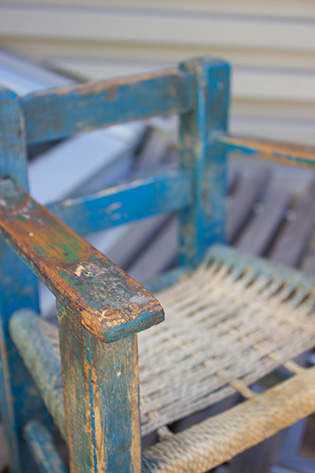 Title: Baby Chair from Godparents
Title: Baby Chair from Godparents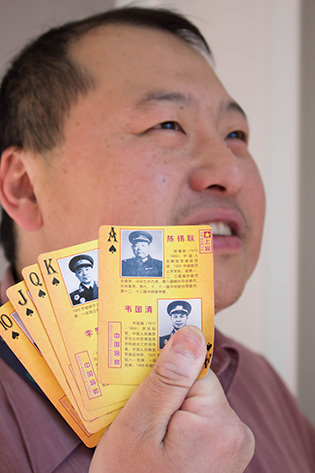 Title: Chinese Marshals & Generals Poker Cards
Title: Chinese Marshals & Generals Poker Cards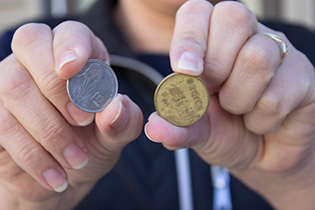 Title: Animal Crackers
Title: Animal Crackers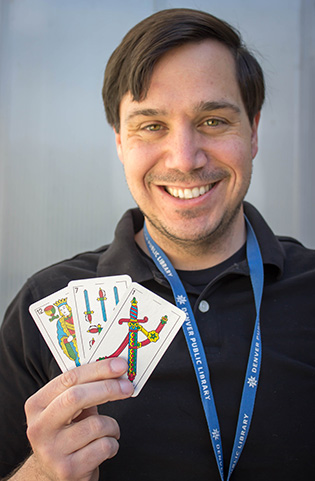 Title: Truco
Title: Truco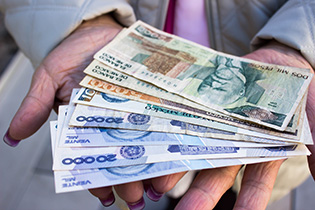 Title: En Mis Zapatos
Title: En Mis Zapatos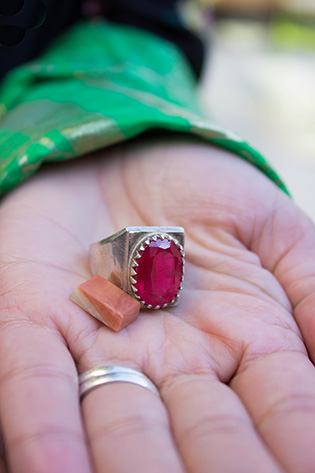 Title: When Worlds Collide
Title: When Worlds Collide